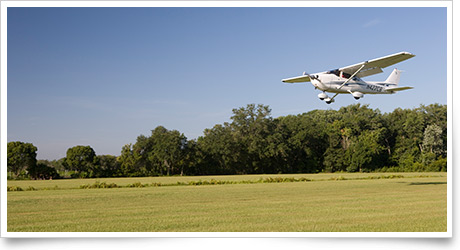| The following stories from the Mar. 30, 2012, edition of AOPA ePilot were provided to AOPA members who expressed an interest in the particular subject areas. Any AOPA member can receive information tailored to their areas of interest by updating their preferences online |
training tipsThe other ‘frequencies’ Be sure to explore this corner of the aviation universe. Perhaps a session practicing landings and takeoffs from short or unpaved strips, or a cross-country flight will take you there. Whether you are a visitor to this realm or a based aviator, knowing the rules and etiquette promotes safety and rounds out your knowledge of aviation’s diverse community. Not every aircraft you spot in the pattern here is capable of making radio position reports. Knowing that no-radio aircraft are present should remind you that “seeing” is the true key to see-and-avoid flying. Checking your sectional chart, or an airport listing, for information about the no-tower, no-unicom airport that is today’s cross-country destination, you note that it is assigned the common traffic advisory frequency 122.9 MHz, as prescribed in Section 4-1-11 of the Aeronautical Information Manual. Make all the usual position reports. It would be wrong to assume, as some pilots do, that such a place cannot become extremely active (especially on a beautiful day in early spring). A related safety tip: Unfortunately, there are still some pilots out there who erroneously make their traffic calls at so-called unattended airports on several of the most familiar of the seven frequencies assigned to airports without an operating control tower (typically, 122.8 MHz)—so it might be a good idea to monitor (but not transmit on) that channel too. Another precaution: Be aware that pilots of local private fixed-wing aircraft that are not coming or going from the airport may be transmitting back and forth on the prescribed air-to-air frequency: 122.75 MHz. (There is also an air-to-air frequency for general aviation helicopters. Would you be able to provide it, if your communications knowledge were probed by a designated examiner on a checkride?) It’s tempting to think of remote or unattended airports as small or unimproved—but that’s not always the case. The unattended airport in Espanola, N.M., has a paved 5,007-foot-long runway, but at a field elevation of 5,790 feet msl, that may not seem especially lengthy when you calculate aircraft performance to be expected under high-density-altitude conditions. training productsNflightcam cockpit video cameras from Sporty’sYou can’t be a fly on the wall of your own airplane, but you can view in-cockpit video footage and listen to yourself on the radio after a flight, thanks to the wave of small HD video cameras on the market. Sporty’s offers the Nflightcam Sport and Plus models. Both feature one-button operation and record full 1080p HD video. Both include software that let the user edit and share videos using Mac or Windows. The Sport sells for $299. The Plus features a lens that eliminates propeller blur and a built-in GPS that logs your position as it records, among other features. The Plus sells for $499. Order online or call 800/776-7897.
Note: Products listed have not been evaluated by ePilot editors unless otherwise noted. AOPA assumes no responsibility for products or services listed or for claims or actions by manufacturers or vendors. final examQuestion: I know I should fly with the most current charts, whether paper or electronic, and I do, but does the information on sectional or terminal area charts really change much over a year or so?
Answer: The short answer is a resounding yes. The FAA's aeronautical charting office, Aeronautical Navigation Products (AeroNav Products), updates terminal area charts and sectional charts every six months. On average, approximately 100 changes are incorporated into each terminal area chart update and 278 in each sectional chart update. Changes include both aeronautical and topographical information. Obviously, since information changes so often, it is in a pilot's best interest to have the most current chart available.
Got a question for our technical services staff? E-mail [email protected] or call the Pilot Information Center, 800/872-2672. Don’t forget the online archive of “Final Exam” questions and answers, searchable by keyword or topic. |
 Away from the hustle and bustle of busy airports and airspace designated by one of the second through fourth letters of the alphabet, general aviation leads a more secluded—but equally active—life.
Away from the hustle and bustle of busy airports and airspace designated by one of the second through fourth letters of the alphabet, general aviation leads a more secluded—but equally active—life.

